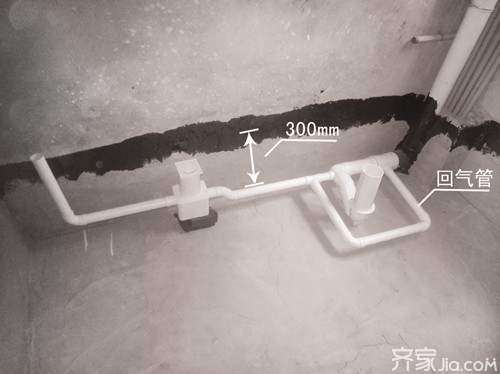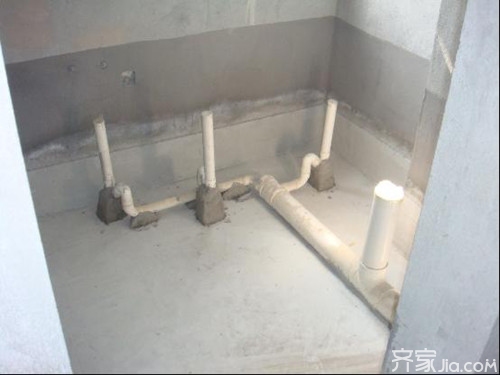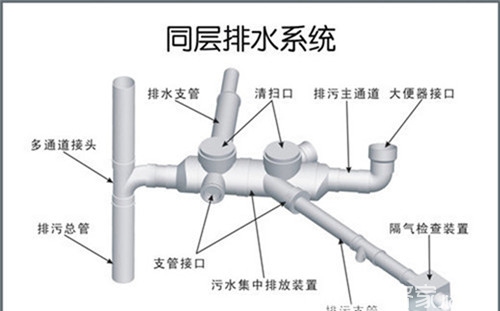The drainage system in the hydropower project that we generally see is connected to the ceiling of the next floor. There is now a technology that can achieve the drainage system to be completed in the same floor so as not to affect the underlying floor and it will be more beautiful. The system is called the same floor drainage. Many people do not know much about the same floor drainage. The same layer of drainage technology in the bathroom is relatively novel at present. The drainage pipe is installed in this layer and a common water-sealing pipe fitting is used instead of many P-bends and S-bends. Once a blockage occurs, this layer can be cleaned and dredged. Many owners are curious about this, and don't know how this technology works. Today, I'll explain to you the introduction of the same floor drainage design.

What does the same layer drain?
The same floor drainage, also called “same floor installationâ€, refers to the construction and laying of the plane in the same floor so that the discharge of sewage and waste reaches or exceeds the same type and other drainage methods and smoothly enters the drainage main pipe (main drainage pipe) once it occurs. Need to clear up the situation, in this layer can solve the problem of drainage. Drainage lateral branch pipe is arranged in the drainage layer or outdoors, and the device drain pipe does not pass the floor drainage method is called the same floor drainage.
The advantages of the same layer of drainage
1. The house property rights are clear: The toilet drainage pipe system is arranged in the home of the owner (house). Pipeline overhaul can be carried out in this house (without interference with the lower occupants).
2. The arrangement of sanitary appliances is not restricted: Because there is no drainage pipe reserved hole for the sanitary appliances on the floor, the user can freely arrange the position of the sanitary appliances to meet the individual requirements of the sanitary ware. The developer can provide a diversified arrangement pattern for the bathroom. Improve the quality of the house.
3. Drainage noise is small: The drain pipe is arranged on the floor and is covered by the backfill cushion, which has better sound insulation effect, so that the drainage noise is greatly reduced.
4. The probability of seepage water is small: bathroom floor boards are not crossed by sanitary equipment pipelines, which reduces the chance of water leakage and effectively prevents the spread of diseases.
5, no need for old-style P-bend or S-bend: access from the "receptacle access device", "multi-function floor drain" and "multi-function water-flow three-way", instead of the P-bend of each sanitary equipment set in the traditional drainage method. S bend. Due to the old P-bend and S-bend and their own insurmountable drawbacks, the same way of installing drainage can be completely solved.
The disadvantage of the same layer of drainage
In fact, there is basically no disadvantage in the same layer drainage, or relative to the advantages it brings. The only drawback is that there is a certain requirement for the floor height. If the floor height is not enough, setting the same floor drainage will make the house look very good. Low, it feels depressing. Many people are worried that once leakage is not maintained, this involves the construction and acceptance of the pipeline operation. If the acceptance is acceptable, the chance of water leakage is extremely low. If the quality of the pipe itself is a problem, the manufacturer needs to bear the loss. Waterproof things have been overlooked. In the past, falling drainage leaks often leaked through vertical pipes leading downstairs. It is not a problem to pay attention to the included angle when waterproofing. Drainage in the same layer does not involve this issue. As long as it is backfilled for waterproofing, even if the waterproof fails, the quality of the tiles will pass (absorbance ≤ 0.5%, standard for all-ceramic tile), and the floor drain will drain smoothly. Water is not so easy to pass through 200~300mm downstairs.

The difference between the same layer drainage and the traditional drainage method
The most fundamental difference is that P-bend and S-bend water traps are not required for water drainage in the same layer, whereas a conventional P-bend or S-bend water seal is required for each sanitary device. P-bends and S-traps are the most prone to blockages. This is the biggest drawback of traditional drainage methods. The use of customary thinking to look at the drainage of the same floor is a place where people do not understand the same floor drainage. The second difference is that the drainage cross pipe of the same floor drainage is laid in the floor cover, while the traditional drainage drainage cross pipe including P bend and S bend is laid through the floor in the lower floor, occupying the space inside the lower floor. The third difference that follows is that in the event of a blockage, the same layer of drainage can achieve the purpose of clearing and unblocking within this layer (opening the multi-channel floor drain or the cover of the access device), and the drainage method must be the same. Go to the lower jacket to clear it.
The scope of application of the same layer of drainage
"House Design Code" (GB50096-1999) Section 6.1.6 stipulates: The residential sewage drainage cross pipe should be located in this layer cover. Regulation 4.3.8 of the Code for the Design of Building Water Supply and Drainage (GB50015-2003) states that the drains for sanitary fixtures in residential toilets should not cross the floor and enter other households. The “Technical Essentials for Healthy House Construction†(2002 edition) 2.2.3 stipulates that the principle of vertical pipeline concentration and horizontal pipeline not to cross the floor should be implemented. The above clauses all express the same concept. The drainage design of residential toilets should use the same layer of drainage.
The same layer of drainage as a novel drainage installation method, it can be applied to the bathroom in any place to replace the traditional drainage method. The so-called application in any case refers to whether it is a multi-storey building or a high-rise building, or a villa. In particular, when the lower occupants or the lower rooms are bedrooms, living rooms, kitchen rooms, and upper floors of the bathrooms, the same floor drainage method should be adopted.
The same level of drainage technology in Europe is a typical and common method of pipeline arrangement in the construction drainage system, and has yet to be developed vigorously in our country's building technology.
Several forms of drainage technology in the same floor
The same layer of drainage technology currently has three main forms (three practices): one is the use of toilet floor (or partial floor) sinking; the second is the use of wall drainage (pipeline concealed installation system as the main feature); The three types are cushioned floors with raised bathroom floors.
1. The sinking method of the bathroom floor is referred to 01SJ914 of Residential Bathrooms. The specific approach is that the floor of the bathroom sinks (local) 30cm, as a pipe laying space. The sinking floor adopts cast-in-place concrete and waterproof layer. It is laid along the surface of the sinking floor along the design elevation and slope. It is filled with lightweight materials such as cement coke as a cushion, and the cushion is leveled with cement mortar. After doing the waterproof layer and surface layer. The 01SJ914 atlas indicates that in this approach, a tube fitting called “multichannel floor drain†should be used.
2. The wall drainage method refers to a fake wall behind the bathroom ware, forming a dedicated space of about 0.2M wide piping. The drainage branch pipe is not laid and installed in the false wall through the floor, and is connected with the supervisor on the same floor. The wall drainage method requires the sanitary ware to use a hanging washbasin and a rear drain toilet. This method achieves the requirements of hygiene, beauty and cleanliness. The inadequacies are: the choice of sanitary appliances is relatively small, the floor drain is difficult to set, the cost is high, and the maintenance of the pipeline is difficult.
3. The method of cushioning the floor of the toilet is not used in this way. The reason is that it is easy to produce “internal water spilloverâ€. Occasionally used in the case of a last resort renovation. There is no more description here.

Analysis of Drainage Design of Residential Bathroom
The drainage form of the same floor of the residential bathroom shall be determined by technical and economic comparison according to the factors such as the arrangement of the bathroom, the sanitary apparatus, and the outdoor ambient temperature. The design principle of the same layer of drainage is as follows:
1. The floor drain is more difficult to handle in the same floor drainage. The floor drain should be set near the sanitary equipment that can easily splash water. It must satisfy the depth of the water seal and have a good hydraulic self-cleaning flow rate. Therefore, only the floor is fully lowered or the floor is lowered locally. This can only be done if the riser is laid on the outside wall.
2. Drainage unobstructed is the core of the same layer of drainage. Therefore, the diameter, slope, and design fullness of the drainage pipe should all comply with the relevant provisions of this code. It is deliberately to reduce the slope and reduce the slope, even for flat slopes. Hidden dangers.
3. Pipeline connections buried in the fill shall be tightly closed to leakage and withstand the test of time. Pipeline connections for bonding and welding shall be recommended.
4. The drainage performance of the sanitary appliance is related to the drop between the drainage outlet and the drainage lateral branch pipe. A too small drop will cause drainage of the sanitary appliance.
5. When the horizontal branch pipe is installed in the trench, the backfill material and surface layer shall be able to carry loads of appliances and equipment.
6. The bathroom floor should take reliable anti-leakage measures, especially for the local drop board and full drop board, in order to avoid the formation of a reservoir layer.
Editor's summary: The above is the relevant description of the drainage design of the same layer of residential bathroom to solve the leakage problem, and hope to help friends who have this requirement! For more information, please continue to pay attention to our website, follow-up will show more exciting content. You can also purchase more of your favorite products on Qijia Mall!
Bathroom design bathroom decoration design loft bathroom decoration design family bathroom decoration design simple glass bathroom decoration design
Enclosed Ceiling Fan,Retractable Ceiling Fan,Cool Ceiling Fans,Mini Ceiling Fan
JIANGMEN ESCLIGHTING TECHNOLOGY LIMITED , https://www.jmwindfansummer.com